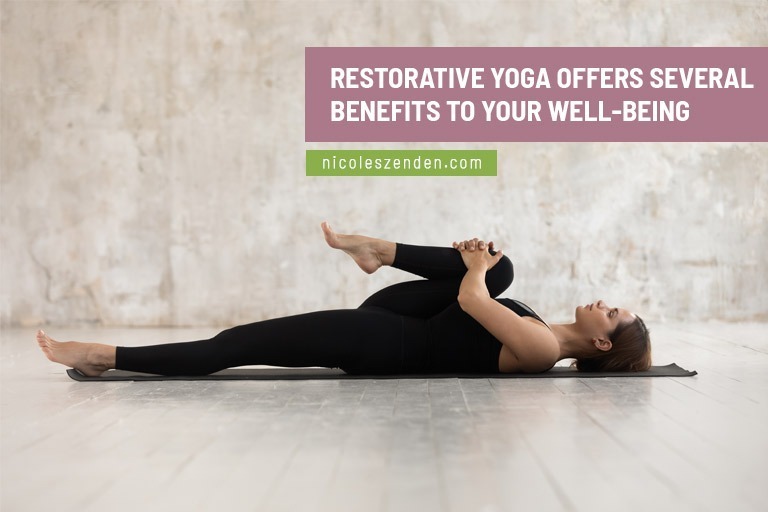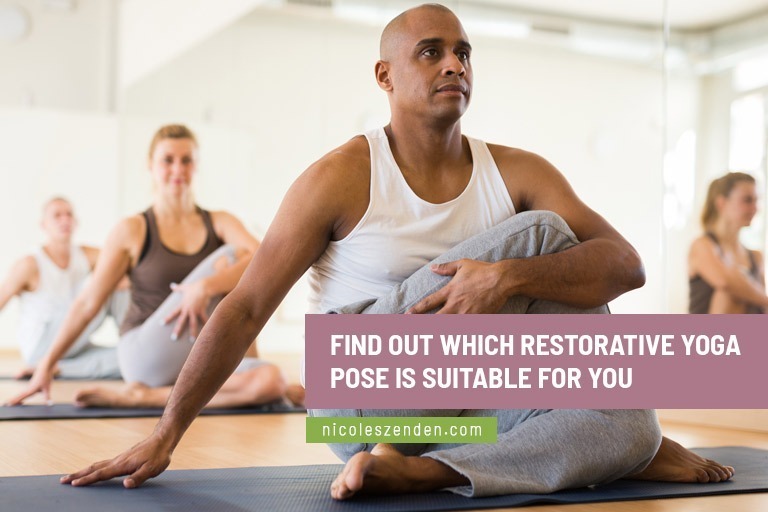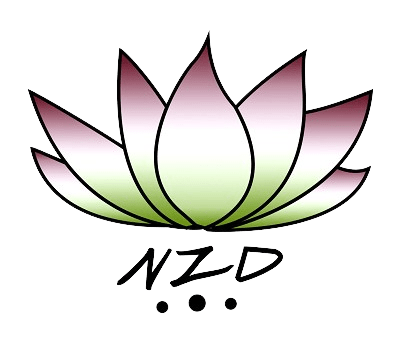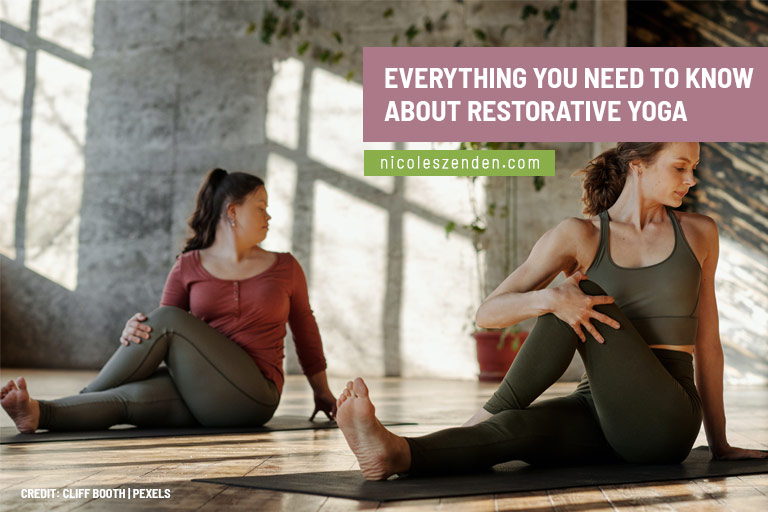Amidst your fast-paced life, where constant demands leave you feeling depleted and overwhelmed, restorative yoga in Toronto offers a soothing antidote. It invites you to connect with your inner self through gentle postures and a deliberate pace.
The magic of this practice unfolds as you surrender to the present moment, offering a tranquil space for self-discovery and renewal. Read on to learn more about restorative yoga, its benefits, and how you can use it to reconnect with yourself.
What Is Restorative Yoga?
Restorative yoga is a relaxing and rejuvenating practice that has gained popularity since the 1970s, thanks to Judith Hanson Lasater‘s pioneering work. Influenced by her teacher B.K.S. Iyengar’s therapeutic approach, Judith introduced the world to restorative yoga, emphasizing comfort, ease, and accessibility.
Restorative yoga in Toronto focuses on returning to something good, not changing or improving. In a world obsessed with doing, achieving, and constant distraction, this practice offers a refreshing path of “active relaxation,” encouraging you to embrace the art of doing “less.”
Designed to be accessible to everyone, even yoga beginners, restorative yoga can be tailored to suit each practitioner’s needs. The practice revolves around simple, prop-supported physical postures in a nurturing and comfortable environment.
Beyond its physical aspects, restorative yoga integrates calming practices like pranayama and meditation. This creates a seamless flow that soothes your nervous system and guides your mind and body into meditative states. The introspective approach invites you to close your eyes and turn your awareness inward, surrendering to the blissful depths of relaxation.
What Are the Benefits of Restorative Yoga?

Here are the key benefits of integrating restorative yoga into your wellness routine:
Deep body relaxation
Restorative yoga invites blissful calm. As a practice known for reducing stress and anxiety, it has been linked to lowering levels of cortisol, the stress hormone, promoting overall well-being.
Enhances healing and balance
Restorative yoga, alongside other yoga styles, may help alleviate pain associated with headaches, back pain, and osteoarthritis, fostering a greater sense of well-being.
Harmonizes the nervous and immune systems
This therapeutic yoga cultivates a sense of inner equilibrium, fostering overall health and resilience by shifting the focus from the fight-or-flight response (sympathetic nervous system) to the relaxation response (parasympathetic nervous system).
Enhanced sleep quality
According to a comprehensive meta-analysis of 19 studies, including restorative yoga, researchers concluded that yoga is an effective intervention for managing sleep problems. Restorative yoga helps promote peaceful and rejuvenating sleep by increasing melatonin production and reducing hyperarousal.
Uplifts your mood
Backed by research, restorative yoga proves to be a valuable tool for managing symptoms of stress, anxiety, depression, and various mood disorders.
Gentle on your body
This nurturing practice is designed to pamper your body, providing a safe and supportive environment. Regular yoga classes in Toronto can strengthen the connective tissue around your joints and bones, enhancing flexibility and overall health.
Discovering Restorative Yoga Poses

While props like bolsters, blocks, or folded blankets enhance the experience, practicing restorative yoga without them is possible. Typically, you need to hold yoga poses for at least 5 minutes, allowing deep relaxation and release. If you find comfort in extending the duration, you can hold a pose for as long as you wish. Some practitioners perform restorative poses for 20 minutes or more.
The key lies in finding what pose feels suitable for you. Here are some of the restorative yoga poses:
Fish pose (matsyasana)
The fish pose helps to counteract the effects of prolonged sitting. Taking deep breaths, you will feel your spine lengthen, your shoulder and neck tension ease, and your chest expand. Spend at least 10 minutes in this rejuvenating pose, allowing your body to unwind and find tranquillity with the support of props.
Child’s pose (balasana)
This pose provides a moment of respite, offering relief from stress and a gentle stretch for your spine, hips, glutes, hamstrings, and shoulders. As you rest your head on the floor or props, you can let your worries melt away, immersing yourself in the calming essence of this pose.
Corpse pose (savasana)
Corpse pose allows you to release tension throughout your body as you rest on supported blankets. Embrace the stillness, close your eyes, and breathe deeply to unwind physically and mentally. Embrace the tranquillity of this meditative pose for at least 10 minutes, savouring its serene effects.
Supported bridge pose (setu bandha sarvangasana)
Supported bridge pose offers your lower back tender care. This pose allows you to experience the gentle opening of your chest and shoulders as you lift your pelvis and support your sacrum with a yoga block.
Legs-up-the-wall pose
The legs-up-the-wall pose helps you relieve leg fatigue and enjoy a soothing stretch. As you rest your legs vertically against a wall, you will feel the gentle release in your hamstrings and the back of your neck. Remain in this restorative pose for a calming 10-minute experience, breathing deeply and letting go of tension throughout your body.
What to Expect in Your Yoga Class
Deep relaxation and rejuvenation await you when you step into a restorative yoga class, in-person or online. The teacher will guide you through the needed props, ensuring your comfort throughout the practice.
In contrast to more active yoga classes, you won’t need to warm up extensively with this practice. Feel free to keep your socks and sweatshirt on if it helps you stay cozy. The teacher may even suggest wrapping yourself in blankets for extra warmth in certain poses.
You’ll indulge in extended holds once you’re settled into a pose with all your props. Let your body unwind and recalibrate into a “rest and digest” state as you move away from the “fight or flight” response. You might even drift off to sleep—an indicator of deep relaxation.
Throughout the practice, your breath remains a guiding anchor. Depending on their style, the teacher might also lead you through meditation or play soothing music. In addition, expect to explore only a few poses during class, as restorative yoga values quality over quantity.
By the end of the session, you’ll feel a delightful sense of openness and refreshment in your body. Your body may feel pleasantly invigorated after a restorative yoga session, even sore the next day, a testament to the power of the practice.
Restorative yoga’s soothing effects on the nervous system profoundly benefit your entire body. As a result of its remarkable ability to regulate the nervous system, regular practice can relieve stress and anxiety, regulate heart rate and blood pressure, and even improve digestion. Undoubtedly a powerful practice, restorative yoga offers far-reaching advantages. So, devote time to practice, and you’ll soon embrace the benefits it brings into your life.
Give Restorative Yoga a Try at Nicole’s Zen Den
Ready to embark on a journey of deep relaxation and rejuvenation? Experience the transformative power of restorative yoga at Nicole’s Zen Den, one of the go-to yoga studios in Toronto. Our classes offer a sanctuary of serenity where you can unwind, find inner peace, and nurture your body, mind, and soul.
Our expert instructors will guide you through blissful poses designed to soothe your nervous system. Schedule your first yoga session with us at Nicole’s Zen Den; reach out to us by dropping an email at info@nicoleszenden.com.

